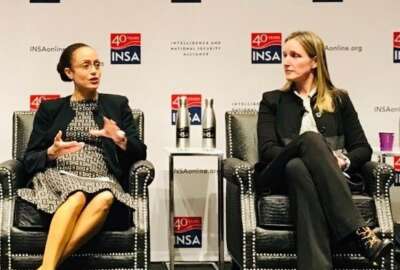These intelligence community trousers might be the best thing since Sansabelt
If they say the clothes make the person, can special clothes make the first responder? The Intelligence Advanced Projects Research Activity (IARPA) wants to find...
If they say the clothes make the person, can special clothes make the first responder? The Intelligence Advanced Projects Research Activity (IARPA) wants to find out. It has launched a program to create trousers that look ordinary, but can record audio, video, and location data. It’s called Smart, Electrically Powered and Networked Textile Systems. Yep. SMART ePANTS. We wondered too. Federal Drive with Tom Temin spoke to IARPA Program Manager Dawson Cagle.
Interview Transcript:
Tom Temin And, well, what the heck are you trying to do here?
Dawson Cagle Well other than make a memorable name. I, we are actually trying to develop the next generation of the Internet of Things. We are moving electronics from your ordinary household items into your clothes, hopefully. That has been a challenge up until now because, frankly, clothes are a difficult environment for electronics. Electronics don’t want to stretch bend. They certainly don’t really like being washed. So we’re trying to solve those problems.
Tom Temin All right. Because you think of electronics as wires, interconnecting physical devices like chips, transistors, resistors and so forth, those keep shrinking. You can get a million transistors in your fingernail, but it’s still a stiff substrate. Ultimately.
Dawson Cagle It’s still a rigid, what we’ve called a puck. So the the problem is oftentimes, how do you get from that rigid puck to the wire? It’s the interconnect. And, you know, when you stretch to reach for something or you bend over to pick something up, that’s stress on your clothes and that interconnect can bear the brunt of it. So trying to do that while you’re washing your clothes or while you’re wearing them is a real challenge. We’re trying to figure out how this can work. And I mean, I think that the main application for it is probably for the medical sector as well as for sports performance.
Tom Temin Right. I was going to ask, what are the applications of this type of thing, especially in IARPA’s context, national security, intelligence gathering. And I think your press release talked about first responders.
Dawson Cagle Sure. Yes, indeed. Years back, I was a weapons inspector at the United Nations. When you are in these environments, usually a factory or some kind of a military base. Very often if you’re carrying around electronics, it’s it can impede your movement in an area. You don’t want to bang your head or touch a corner or, you know, run into something that while you’re not paying attention. So it’s super helpful to be able to have any kind of recording equipment that you would want physically part of your body instead of carrying it around so you don’t have a free hand. That goes for law enforcement as well. And certainly in high other high stress environments, certainly our colleagues in the military also have that need.
Tom Temin Now, when you think of electronics in the chain of events leading to, say, an audio or video recording, you can imagine a flexible substrate for the supporting electronics. They make a rubber circuit boards now and the fabric, bendable boards have been around for a while. But when you think of the input device, a microphone or a camera, a camera has to have a lens. And a lens is a hard typically thing that bends light made of glass that seems hard to incorporate.
Dawson Cagle Let me tell you, it is. We do have some really fascinating shots on goal for that, though. We have some colleagues both at MIT and at the University of Michigan, which have already built and published their work on stretchable, bendable microphones in threads that has been done. There are all kinds of applications for us, but I also imagine that it could be used for listening to your heartbeat. Yes, that is difficult. It turns out that you just as you can imagine, that when fabric goes over the top of your microphone and you hear that brushing sound, it’s equally difficult if it’s actually physically built into your clothes. So there’s extra work that you have to do to make it quiet.
Tom Temin Yeah, there’s a lot of signal processing and maybe some, let’s say it artificial intelligence. It has to be amazing.
Dawson Cagle Yeah. Yeah, I would imagine that’s the case. And we have a lot of experts working on audio processing in the effort. Likewise, one of the things that has been a surprise for me is if you have many small cameras, when when I say small, I mean less than like the width of two pieces, two fishing lines, if you have many of them, just like the eyelets on a fly. On the on the eye of a fly. Sure. You can actually have those simple cameras be threaded together into a computer and stitch together an image in with shocking resolution.
Tom Temin Wow. We’re speaking with Dawson Cagle. He’s a program manager at IARPA, the Intelligence Advanced Research Projects Activity. How are you going about getting these samples? Getting. Is this a grant program you’re running? Tell us about the program aspects of SMART ePANTS.
Dawson Cagle SMART ePANTS is a research program out of my out of IARPA. We put out a solicitation for researchers to answer the our needs. Last year, we started in July of this year, we’ve hired five different groups. They have up to ten team members inside those groups. And they’re actually working to satisfy the numeric metrics that we have in the program. So, for example, for audio, it’s a 60 minute conversation with at 60 decibels. So they and then I guess within one meter distance. So we set the exact parameters that are needed in order to meet our metrics. The fun thing is that in addition to gathering that data, we also ask for the same piece of electronics to meet certain fabric testing requirements. We want to make sure that everybody gets treated equally. So we have worked with our friends in the fabric and textile industry to actually build machines and to test on certain standards that what is it the American Association of Textile Colorists has for building fabrics. I never thought I would learn this stuff. I also didn’t think I would learn so much about textile design and garment design and even fashion design. Sure. We actually have a wedding dress designer under contract.
Tom Temin Wow. Yeah. Well, these things do evolve over time, I suppose. I mean, look how uncomfortable polyester was 40 years ago, and now it’s almost preferred, you know. Oh, my goodness. A natural fit. Yeah, I guess my question is, why? Fundamentally, I mean, if you want someone to be able to gather data, you can easily do that now with goggles, you know, in a Bluetooth connection to something that’s really in, for practical purposes, highly wearable or, you know, people for looking at medical sensing. There are Fitbit types of devices, wrist worn ring worn on your finger and whatever. What will this advance, do you think?
Dawson Cagle Well, I think that certainly what you say is very true. We can already record audio and video on our phones. And this is actually what a lot of the industry is thinking when they have looked at this in the past. That’s actually the reason why it hasn’t gone any further, is because so far there’s been no sort of killer app for how you how you actually receive this information or record information. Everybody can already do that on their phones. So what we’re hoping is that there will be new applications found, certainly. I mean, my my own dad is a Type one diabetic. I was considering, you know, his compliance with checking his blood sugar. If he has to carry around his glucometer all the time, he’s less likely to actually do the measurement. There are efforts at putting that into the pocket of a watch or of a phone. But if you were simply wearing the device, it was something that you put on every day. Then patient compliance gets much, much better. So I’m hoping that that is actually one of the big applications from my conversations with folks in the medical community. They certainly sound very interested.
Tom Temin But with respect to recording externally, say like the shirt itself is a sensor that can hear and see, then storage would also be incorporated.
Dawson Cagle Storage would be incorporated, yes.
Tom Temin What about the privacy and just creepiness aspect of your shirt is recording me or you’re, you’re not doing hats, You’re doing. . .
Dawson Cagle No hats, no hats.
Tom Temin It’s something that it’s worn organically from head to toe, something neck to toe.
Dawson Cagle We generally say something that’s touching the skin.
Tom Temin So if someone takes off their shoe while they’re talking to you, you might get the idea. That’s a smart sock.
Dawson Cagle Yes. Smart socks. That’s in play. I would say, you know, we at IARPA pay a great deal of attention to civil liberties, personal privacy, and we’ve baked that into the program. We’re not actually doing any testing on people. And our effort is really not so much what we’re recording as how. So the how part of the question is the part that hasn’t been answered. I actually think that the sensor is the least of my worries. The biggest part of my worries are actually the interconnects, the battery. How do you make a washy, stretchy battery?
Tom Temin And that’s where the buttons come in, right?
Dawson Cagle And the buttons. So interestingly, the buttons in the, that’s called haptics. It’s actually one of the more interesting parts. If you look at how weave is done on a garment, there’s two directions that the threads go, right?
Tom Temin And it’s called the warp.
Dawson Cagle That’s the twisty part. And the other is called the weft. Right. And the warp and weft.
Tom Temin Right. That’s how a loom works.
Dawson Cagle That’s exactly right. There are researchers in our teams that have worked to build different kinds of wires that can be put in the warp and the weft that you press together to form a switch. So you could actually have a fabric switch. So, I mean, this this. The innovation is amazing, watching how the different parts that you would assume go into a rigid puck and how you put that into fabric.
Tom Temin And what is your timeline on getting, say, a prototype?
Dawson Cagle Well, I get prototypes in three stages on the program. The first one is in just a year and a half. The teams need to put all of the pieces together and to put them on some kind of a flexible swatch of fabric or something similar. And then one year later, I get my first garments. And then third is a garment that you can actually wear around and wash. All of that is like three and a half years.
Tom Temin One of these days we’ll say, ‘You want to have lunch? Well, I’ll have my shirt, call your socks,’ and we can get together and decide when we get together.
Dawson Cagle I love that
Copyright © 2024 Federal News Network. All rights reserved. This website is not intended for users located within the European Economic Area.
Tom Temin is host of the Federal Drive and has been providing insight on federal technology and management issues for more than 30 years.
Follow @tteminWFED






